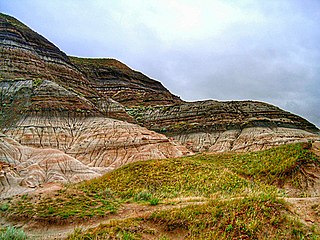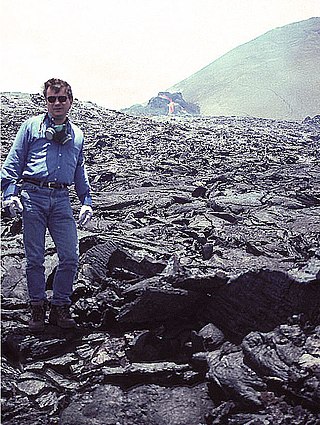Related Research Articles

An extinction event is a widespread and rapid decrease in the biodiversity on Earth. Such an event is identified by a sharp fall in the diversity and abundance of multicellular organisms. It occurs when the rate of extinction increases with respect to the background extinction rate and the rate of speciation. Estimates of the number of major mass extinctions in the last 540 million years range from as few as five to more than twenty. These differences stem from disagreement as to what constitutes a "major" extinction event, and the data chosen to measure past diversity.

An impact event is a collision between astronomical objects causing measurable effects. Impact events have physical consequences and have been found to regularly occur in planetary systems, though the most frequent involve asteroids, comets or meteoroids and have minimal effect. When large objects impact terrestrial planets such as the Earth, there can be significant physical and biospheric consequences, though atmospheres mitigate many surface impacts through atmospheric entry. Impact craters and structures are dominant landforms on many of the Solar System's solid objects and present the strongest empirical evidence for their frequency and scale.
Nemesis was a hypothetical red dwarf or brown dwarf, originally postulated in 1984 to be orbiting the Sun at a distance of about 95,000 AU, somewhat beyond the Oort cloud, to explain a perceived cycle of mass extinctions in the geological record, which seem to occur more often at intervals of 26 million years. In a 2017 paper, Sarah Sadavoy and Steven Stahler argued that the Sun was probably part of a binary system at the time of its formation, leading them to suggest "there probably was a Nemesis, a long time ago". Such a star would have separated from this binary system over four billion years ago, meaning it could not be responsible for the more recent perceived cycle of mass extinctions.

In geology, catastrophism is the theory that the Earth has largely been shaped by sudden, short-lived, violent events, possibly worldwide in scope. This contrasts with uniformitarianism, according to which slow incremental changes, such as erosion, brought about all the Earth's geological features. The proponents of uniformitarianism held that the present was "the key to the past", and that all geological processes throughout the past resembled those that can be observed today. Since the 19th-century disputes between catastrophists and uniformitarians, a more inclusive and integrated view of geologic events has developed, in which the scientific consensus accepts that some catastrophic events occurred in the geologic past, but regards these as explicable as extreme examples of natural processes which can occur.

An impact winter is a hypothesized period of prolonged cold weather due to the impact of a large asteroid or comet on the Earth's surface. If an asteroid were to strike land or a shallow body of water, it would eject an enormous amount of dust, ash, and other material into the atmosphere, blocking the radiation from the Sun. This would cause the global temperature to decrease drastically. If an asteroid or comet with the diameter of about 5 km (3.1 mi) or more were to hit in a large deep body of water or explode before hitting the surface, there would still be an enormous amount of debris ejected into the atmosphere. It has been proposed that an impact winter could lead to mass extinction, wiping out many of the world's existing species. The Cretaceous–Paleogene extinction event probably involved an impact winter, and led to mass extinction of most tetrapods weighing more than 25 kilograms.

In planetary astronomy and astrobiology, the Rare Earth hypothesis argues that the origin of life and the evolution of biological complexity such as sexually reproducing, multicellular organisms on Earth required an improbable combination of astrophysical and geological events and circumstances.

Nalin Chandra Wickramasinghe is a Sri Lankan-born British mathematician, astronomer and astrobiologist of Sinhalese ethnicity. His research interests include the interstellar medium, infrared astronomy, light scattering theory, applications of solid-state physics to astronomy, the early Solar System, comets, astrochemistry, the origin of life and astrobiology. A student and collaborator of Fred Hoyle, the pair worked jointly for over 40 years as influential proponents of panspermia. In 1974 they proposed the hypothesis that some dust in interstellar space was largely organic, later proven to be correct.
The Shiva crater is the claim by paleontologist Sankar Chatterjee and colleagues that the Bombay High and Surat Depression on the Indian continental shelf west of Mumbai, India represent a 500-kilometre (310 mi) impact crater, that formed around the Cretaceous-Paleogene boundary. Chatterjee and colleagues have claimed that this could have contributed to the K-Pg extinction event. Other scholars have questioned the claims, finding that there is no evidence of an impact structure.

The Milky Way is the galaxy that includes the Solar System, with the name describing the galaxy's appearance from Earth: a hazy band of light seen in the night sky formed from stars that cannot be individually distinguished by the naked eye. The term Milky Way is a translation of the Latin via lactea, from the Greek γαλαξίας κύκλος, meaning "milky circle". From Earth, the Milky Way appears as a band because its disk-shaped structure is viewed from within. Galileo Galilei first resolved the band of light into individual stars with his telescope in 1610. Until the early 1920s, most astronomers thought that the Milky Way contained all the stars in the Universe. Following the 1920 Great Debate between the astronomers Harlow Shapley and Heber Doust Curtis, observations by Edwin Hubble showed that the Milky Way is just one of many galaxies.

The formation of the Solar System began about 4.6 billion years ago with the gravitational collapse of a small part of a giant molecular cloud. Most of the collapsing mass collected in the center, forming the Sun, while the rest flattened into a protoplanetary disk out of which the planets, moons, asteroids, and other small Solar System bodies formed.
William M. (Bill) Napier is the author of five high tech thriller novels and a number of nonfiction science books.

A galactic tide is a tidal force experienced by objects subject to the gravitational field of a galaxy such as the Milky Way. Particular areas of interest concerning galactic tides include galactic collisions, the disruption of dwarf or satellite galaxies, and the Milky Way's tidal effect on the Oort cloud of the Solar System.

The Cretaceous–Paleogene (K–Pg) boundary, formerly known as the Cretaceous–Tertiary (K–T) boundary, is a geological signature, usually a thin band of rock containing much more iridium than other bands. The K–Pg boundary marks the end of the Cretaceous Period, the last period of the Mesozoic Era, and marks the beginning of the Paleogene Period, the first period of the Cenozoic Era. Its age is usually estimated at 66 million years, with radiometric dating yielding a more precise age of 66.043 ± 0.011 Ma.
Stace Victor Murray Clube is an English astrophysicist.

In astronomy, the Hills cloud is a vast theoretical circumstellar disc, interior to the Oort cloud, whose outer border would be located at around 20,000 to 30,000 astronomical units (AU) from the Sun, and whose inner border, less well defined, is hypothetically located at 250–1500 AU, well beyond planetary and Kuiper Belt object orbits—but distances might be much greater. If it exists, the Hills cloud contains roughly 5 times as many comets as the Oort cloud.

The biological and geological future of Earth can be extrapolated based on the estimated effects of several long-term influences. These include the chemistry at Earth's surface, the cooling rate of the planet's interior, the gravitational interactions with other objects in the Solar System, and a steady increase in the Sun's luminosity. An uncertain factor is the pervasive influence of technology introduced by humans, such as climate engineering, which could cause significant changes to the planet. For example, the current Holocene extinction is being caused by technology, and the effects may last for up to five million years. In turn, technology may result in the extinction of humanity, leaving the planet to gradually return to a slower evolutionary pace resulting solely from long-term natural processes.
Adrian Lewis Melott is an American physicist. He is one of the pioneers of using large-scale computing to investigate the formation of large-scale structure in a Universe dominated by dark matter. He later turned his attention to an area he calls “astrobiophysics”, examining a variety of ways that external events in our galaxy may have influenced the course of life on Earth, including analysis of gamma-ray burst events.
This glossary of astronomy is a list of definitions of terms and concepts relevant to astronomy and cosmology, their sub-disciplines, and related fields. Astronomy is concerned with the study of celestial objects and phenomena that originate outside the atmosphere of Earth. The field of astronomy features an extensive vocabulary and a significant amount of jargon.

In astrobiology and planetary astrophysics, the galactic habitable zone is the region of a galaxy in which life might most likely develop. The concept of a galactic habitable zone analyzes various factors, such as metallicity and the rate and density of major catastrophes such as supernovae, and uses these to calculate which regions of a galaxy are more likely to form terrestrial planets, initially develop simple life, and provide a suitable environment for this life to evolve and advance. According to research published in August 2015, very large galaxies may favor the birth and development of habitable planets more than smaller galaxies such as the Milky Way. In the case of the Milky Way, its galactic habitable zone is commonly believed to be an annulus with an outer radius of about 10 kiloparsecs (33,000 ly) and an inner radius close to the Galactic Center.

Michael R. Rampino is a Geologist and Professor of Biology and Environmental Studies at New York University, known for his scientific contributions on causes of mass extinctions of life. Along with colleagues, he's developed theories about periodic mass extinctions being strongly related to the earth's position in relation to the galaxy. "The solar system and its planets experience cataclysms every time they pass "up" or "down" through the plane of the disk-shaped galaxy." These ~30 million year cyclical breaks are an important factor in evolutionary theory, along with other longer 60-million- and 140-million-year cycles potentially caused by mantle plumes within the planet, opining "The Earth seems to have a pulse," He is also a research consultant at NASA's Goddard Institute for Space Studies (GISS) in New York City.
References
- ↑ Napier, WM; Clube, SVM (1979). "A theory of terrestrial catastrophism". Nature. 282 (5738): 455–459. Bibcode:1979Natur.282..455N. doi:10.1038/282455a0. S2CID 35238984.
- ↑ Rampino, Michael R; Stothers, Richard B (1984). "Terrestrial mass extinctions, cometary impacts and the Sun's motion perpendicular to the galactic plane". Nature. 308 (5961): 709–712. Bibcode:1984Natur.308..709R. doi:10.1038/308709a0. S2CID 4256690.
- ↑ Rampino, Michael R.; Haggerty, Bruce M. (February 1996). "The ?Shiva Hypothesis?: Impacts, mass extinctions, and the galaxy". Earth, Moon, and Planets. 72 (1–3): 441–460. Bibcode:1996EM&P...72..441R. doi:10.1007/BF00117548. S2CID 189901526.
- ↑ Rampino, Michael R.; Caldeira, Ken; Zhu, Yuhong (2020). "A 27.5-My underlying periodicity detected in extinction episodes of non-marine tetrapods". Historical Biology. 33 (11): 3084–3090. doi:10.1080/08912963.2020.1849178.
- ↑ Gillman, M.; Erenler, H. (2008). "The galactic cycle of extinction" (PDF). International Journal of Astrobiology . 7 (1): 17–26. Bibcode:2008IJAsB...7...17G. CiteSeerX 10.1.1.384.9224 . doi:10.1017/S1473550408004047. S2CID 31391193.
- ↑ Overholt, Andrew C.; Melott, Adrian L.; Pohl, Martin (2009). "Testing the Link Between Terrestrial Climate Change and Galactic Spiral Arm Transit". The Astrophysical Journal. 705 (2): L101–L103. arXiv: 0906.2777 . Bibcode:2009ApJ...705L.101O. doi:10.1088/0004-637X/705/2/L101. S2CID 734824.
- ↑ Leslie Mullen. "Getting WISE About Nemesis". Astrobiology Magazine. Archived from the original on 2010-03-14. Retrieved 11 February 2021.
- ↑ Algeo, Thomas J; Shen, Jun (2023-09-08). "Theory and classification of mass extinction causation". National Science Review. doi: 10.1093/nsr/nwad237 . ISSN 2095-5138. PMC 10727847 .